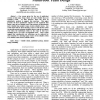Free Online Productivity Tools
i2Speak
i2Symbol
i2OCR
iTex2Img
iWeb2Print
iWeb2Shot
i2Type
iPdf2Split
iPdf2Merge
i2Bopomofo
i2Arabic
i2Style
i2Image
i2PDF
iLatex2Rtf
Sci2ools
IROS
2006
IEEE
2006
IEEE
Mission Reliability Estimation for Multirobot Team Design
One reason given for the use of multirobot systems is that many cheap robots are more reliable than one expensive robot. To date, however, there has been no quantitative analysis to support this assertion. This paper presents the first quantitative support for the argument that larger teams of less-reliable robots can perform certain missions more reliably than smaller teams of more-reliable robots. Our results show that for short missions, in fact, a team of four robots can provide greater mission reliability than a team of two robots, even when the individual robots in the team of four have reliability that is an order of magnitude lower. These results suggest that considerable cost reductions can be achieved for some missions by choosing larger teams of less-reliable robots over smaller teams of more-reliable robots.
IROS 2006 | Less-reliable Robots | Robotics | Robots | Teams |
| Added | 12 Jun 2010 |
| Updated | 12 Jun 2010 |
| Type | Conference |
| Year | 2006 |
| Where | IROS |
| Authors | S. B. Stancliff, John M. Dolan, Ashitey Trebi-Ollennu |
Comments (0)

